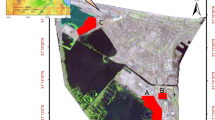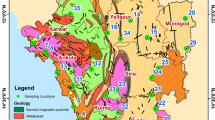Abstract
The radiation arising from naturally occurring radioactive materials (NORMs) is the foremost contributor to the collective dose received by the global population. The present study aims to measure the natural background radiation level and the associated gamma radiation dose in air in the Beldih apatite mine region of Purulia district, India. This study is primarily focused on the determination of 238U, 232Th and 40K activities in the sub-surface soil of the study area. The measurements were carried out using a High Purity Germanium (HPGe) detector-based gamma-ray spectrometer with a relative efficiency of 80%. To achieve uniformity in exposure estimations, radium equivalent activity has been calculated. Additionally, the internal hazard index, external hazard index, radioactivity level index and gamma dose rates have been evaluated to estimate the radiation hazard levels in the study area. The comparison of obtained concentrations and hazard indices with global data (UNSCEAR. (2008). Sources, effects and risks of ionizing radiation. United nations scientific committee on the effects of atomic radiation (report to the general assembly, with Annexes).) suggests that this region lies in a relatively high background radiation zone.








Similar content being viewed by others
References
Acharyya, A., Ray, S., Chaudhuri, B. K., Basu, S. K., Bhaduri, S. K., & Sanyal, A. K. (2006). Proterozoic rock suites along South Purulia Shear Zone, Eastern India: Evidence for rift-related setting. Geological Society of India., 68(6), 1069–1086.
Barkat, A., Ali, A., Hayat, U., Crowley, Q. G., Rehman, K., Siddique, N., Haidar, T., & Iqbal, T. (2018). Time series analysis of soil radon in Northern Pakistan: Implications for earthquake forecasting. Applied Geochemistry, 97, 197–208. https://doi.org/10.1016/j.apgeochem.2018.08.016
Belyaeva, O., Pyuskyulyan, K., Movsisyan, N., Saghatelyan, A., & Carvalho, F. P. (2019). Natural radioactivity in urban soils of mining centers in Armenia: Dose rate and risk assessment. Chemosphere, 225, 859–870. https://doi.org/10.1016/j.chemosphere.2019.03.057
Beretka, J., & Mathew, P. J. (1985). Natural radioactivity of Australian building materials, industrial wastes and by-products. Health Physics., 48(1), 87–95.
European Commission. (1999). Radiological protection principles concerning the natural radioactivity of building materials, Radiation Protection Report—RP-112. European Commission, Luxembourg.
Ehmann, W. D., & Vance, D. E. (1993). Radiochemistry and nuclear methods of analysis.
Flores, O. B., Estrada, A. M., Suarez, R. R., Zerquera, J. T., & Pérez, A. H. (2008). Natural radionuclide content in building materials and gamma dose rate in dwellings in Cuba. Journal of Environmental Radioactivity, 99(12), 1834–1837. https://doi.org/10.1016/j.jenvrad.2008.08.001
IAEA/RL/148. (1987). https://inis.iaea.org/collection/NCLCollectionStore/_Public/18/088/18088420.pdf?r=1
ICRP (International Commission on Radiological Protection). (1994). Protection Against 222Rn at home and at work. ICRP Publication-Pergamon Press.
International Atomic Energy Agency. (1989). Measurement of radionuclides in food and the environment a guidebook. Technical Reports Series No. 295, Vienna.
Joel, E. S., Maxwell, O., Adewoyin, O. O., Olawole, O. C., Arijaje, T. E., Embong, Z., & Saeed, M. A. (2019). Investigation of natural environmental radioactivity concentration in soil of coastaline area of Ado-Odo/Ota Nigeria and its radiological implications. Scientific Reports., 9(1), 4219. https://doi.org/10.1038/s41598-019-40884-0
Katti, V. J., Sen, J., & Bhatt, A. K. (2010). Uranium potentiality of south Purulia Shear Zone, eastern India shield. IAEA.
Khan, I. U., Sun, W., & Lewis, E. (2020). Review of low-level background radioactivity studies conducted from 2000 to date in people Republic of China. Journal of Radiation Research and Applied Science, 13(1), 406–415. https://doi.org/10.1080/16878507.2020.1744330
Krieger, R. (1981). Radioactivity of construction materials. Betonwerk Und Fertigteil Technik, 47, 468–473.
Liu, G., Luo, Q., Ding, M., & Feng, J. (2015). Natural radionuclides in soil near a coal-fired power plant in the high background radiation area, South China. Environmental Monitoring and Assessment, 187, 356.
Mandal, A., Biswas, A., Mittal, S., Mohanty, W. K., Sharma, S. P., Sengupta, D., Sen, J., & Bhatt, A. K. (2013). Geophysical anomalies associated with uranium mineralization from Beldih mine, South Purulia Shear Zone, India. Journal of Geological Society of India., 82, 601–606. https://doi.org/10.1007/s12594-013-0197-1
Mitrović, B., Ajtić, J., Lazić, M., Andrić, V., Krstić, N., Vranješ, B., & Vićentijević, M. (2016). Natural and anthropogenic radioactivity in the environment of Kopaonik mountain, Serbia. Environmental Pollution, 215, 273–279. https://doi.org/10.1016/j.envpol.2016.05.031
Mittal, S., Guin, R., Sharma, S. P., & Sengupta, D. (2013). Estimation of 238U, 232Th and 40K concentrations in rock and soil samples around South Purulia Shear Zone, India. International Journal of Low Radiation, 9(2), 110–118. https://doi.org/10.1504/IJLR.2013.055602
Naskar, N., Lahiri, S., & Chaudhuri, P. (2018). Anomalies in quantitative measurement of 40K in natural samples. Journal of Radioanalytical and Nuclear Chemistry, 316, 709–715. https://doi.org/10.1007/s10967-018-5777-5
Naskar, N., Lahiri, S., Chaudhuri, P., & Srivastava, A. (2016). Measurement of naturally occurring radioactive materials, 238 U and 232 Th: Anomalies in photopeak selection. Journal of Radioanalytical and Nuclear Chemistry, 310, 1381–1396. https://doi.org/10.1007/s10967-016-4988-x
Naskar, N., Lahiri, S., Chaudhuri, P., & Srivastava, A. (2017). Measurement of naturally occurring radioactive material, 238U and 232Th- part-2: Optimization of counting time. Journal of Radioanalytical and Nuclear Chemistry, 312, 161–171. https://doi.org/10.1007/s10967-017-5205-2
Naskar, N., Lahiri, S., & Jandu, S. (2020). Optimization of counting time for measurement of ultra-low-level 238U and 232Th by 80% relative efficiency HPGe detector. Journal of Radiation and Nuclear Applications, 5(3), 201–204.
Naskar, N., Shaha, C., Ghosh, A., & Gangopadhyay, K. (2023). Study on distribution of radionuclides in soil and pottery samples of archeological sites of eastern India. Journal of Radioanalytical and Nuclear Chemistry. https://doi.org/10.1007/s10967-023-09214-7
NEA-OECD (Organization for Economic Co-operation and Development). (1979). Exposure to radiation from radioactivity in building materials. Report by a Group of Experts of The OECD Nuclear Energy Agency.
Ojovan, M. I., Lee, W. E., & Kalmykov, S. N. (2019). An introduction to nuclear waste immobilization. Elsevier.
Patnaik, R. L., Kumar, A., Jha, V. N., Kumar, R., Patil, S., Sahoo, L., Jha, S. K., & Tripathi, R. M. (2018). Mobile Radiological mapping around the Jaduguda area of Jharkhand, India. In Proceedings of the thirty-third IARP international conference on developments toward improvement of radiological surveillance at nuclear facilities and environment.
Ramola, R. C., Gusain, G. S., Badoni, M., Prasad, Y., Prasad, G., & Ramachandran, T. V. (2008). 226Ra, 232Th and 40K contents in soil samples from Garhwal Himalaya, India, and its radiological implications. Journal of Radiological Protection, 28(3), 379. https://doi.org/10.1088/0952-4746/28/3/008
Ramsiya, M., Joseph, A., Eappen, K. P., & Visnuprasad, A. K. (2019). Activity concentrations of radionuclides in soil samples along the coastal areas of Kerala, India and the assessment of radiation hazard indices. Journal of Radioanalytical and Nuclear Chemistry, 320, 291–298. https://doi.org/10.1007/s10967-019-06481-1
UNSCEAR. (2000). United nations scientific committee on the effects of atomic radiation. Sources and effects of ionizing radiation. Report to the general assembly, annexe B. United Nations Publication, United Nations, New York.
UNSCEAR. (2008). Sources, effects and risks of ionizing radiation. United nations scientific committee on the effects of atomic radiation (report to the general assembly, with Annexes).
Zhang, S., Zhang, X., Liu, X., Liu, W., & Liu, Z. (2013). Spatial distribution of soil nutrient at depth in black soil of Northeast China: A case study of soil available potassium. Nutrient Cycling in Agroecosystems, 95, 319–331.
Acknowledgements
Nabanita Naskar acknowledges DST INSPIRE Faculty Fellowship (IFA21-EAS 99, Sanction no.: DST/INSPIRE/04/2021/003612 dated 28-03-2023). Susanta Lahiri acknowledges the CSIR Emeritus Scientist Scheme, Govt. of India. Chiranjib Barman acknowledges the financial assistance from Department of Science & Technology-Fund for Improvement of Science & Technology Infrastructure, New Delhi, India; Rashtriya Uchchatar Shiksha Abhiyan grant of Sidho-Kanho-Birsha University; University Grant Commissions-Faculty Research Promotion Scheme Start-up-Grant; seed grant of faculty research, Sidho-Kanho-Birsha University.
Funding
The authors acknowledge the financial support given by Department of Science & Technology-Fund for Improvement of Science & Technology Infrastructure (SR/FST/PS-1/2020/159) New Delhi, India; Rashtriya Uchchatar Shiksha Abhiyan grant of Sidho-Kanho-Birsha University; University Grant Commissions-Faculty Research Promotion Scheme Start-up-Grant [(No.F.30–557/2021(BSR) Dated: 21 Jan, 2022)]; seed grant of faculty research, Sidho-Kanho-Birsha University (R/847/SKBU/2022 dated 20th July, 2022).
Author information
Authors and Affiliations
Contributions
SM contributed to Sample collection, methodology, sample preparation, data analysis, validation, writing—original draft. NN contributed to Conceptualization, methodology, sample preparation, data analysis, validation, writing—original draft, overall correction. JM contributed to Sample Collection, sample preperation. SS: Sample collection, sample preparation. SL contributed to Conceptualization, methodology, supervision, resources, writing—overall correction. CB contributed to Sample collection, supervision, funding acquisition, resources, writing—overall correction. SM was a major contributor in writing the original manuscript. All authors read and approved the final manuscript.
Corresponding author
Ethics declarations
Competing interests
The authors declare no competing interests.
Conflict of interest
The authors declare that there is no conflict of interest that could have influenced this work.
Consent to publish
All of the authors listed in the manuscript have agreed to be authors. All authors have read and accepted the work and have given their approval to the final manuscript’s submission and future publication.
Additional information
Publisher's Note
Springer Nature remains neutral with regard to jurisdictional claims in published maps and institutional affiliations.
Rights and permissions
Springer Nature or its licensor (e.g. a society or other partner) holds exclusive rights to this article under a publishing agreement with the author(s) or other rightsholder(s); author self-archiving of the accepted manuscript version of this article is solely governed by the terms of such publishing agreement and applicable law.
About this article
Cite this article
Mitra, S., Naskar, N., Mukherjee, J. et al. Assessment of NORMs (238U, 232Th, 40K) and radiation hazard indices in Beldih apatite mine region of Purulia district, West Bengal, India. Environ Geochem Health 46, 66 (2024). https://doi.org/10.1007/s10653-023-01844-w
Received:
Accepted:
Published:
DOI: https://doi.org/10.1007/s10653-023-01844-w




